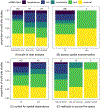Macroimmunology: The drivers and consequences of spatial patterns in wildlife immune defence
- PMID: 31856309
- PMCID: PMC7138727
- DOI: 10.1111/1365-2656.13166
Macroimmunology: The drivers and consequences of spatial patterns in wildlife immune defence
Abstract
The prevalence and intensity of parasites in wild hosts varies across space and is a key determinant of infection risk in humans, domestic animals and threatened wildlife. Because the immune system serves as the primary barrier to infection, replication and transmission following exposure, we here consider the environmental drivers of immunity. Spatial variation in parasite pressure, abiotic and biotic conditions, and anthropogenic factors can all shape immunity across spatial scales. Identifying the most important spatial drivers of immunity could help pre-empt infectious disease risks, especially in the context of how large-scale factors such as urbanization affect defence by changing environmental conditions. We provide a synthesis of how to apply macroecological approaches to the study of ecoimmunology (i.e. macroimmunology). We first review spatial factors that could generate spatial variation in defence, highlighting the need for large-scale studies that can differentiate competing environmental predictors of immunity and detailing contexts where this approach might be favoured over small-scale experimental studies. We next conduct a systematic review of the literature to assess the frequency of spatial studies and to classify them according to taxa, immune measures, spatial replication and extent, and statistical methods. We review 210 ecoimmunology studies sampling multiple host populations. We show that whereas spatial approaches are relatively common, spatial replication is generally low and unlikely to provide sufficient environmental variation or power to differentiate competing spatial hypotheses. We also highlight statistical biases in macroimmunology, in that few studies characterize and account for spatial dependence statistically, potentially affecting inferences for the relationships between environmental conditions and immune defence. We use these findings to describe tools from geostatistics and spatial modelling that can improve inference about the associations between environmental and immunological variation. In particular, we emphasize exploratory tools that can guide spatial sampling and highlight the need for greater use of mixed-effects models that account for spatial variability while also allowing researchers to account for both individual- and habitat-level covariates. We finally discuss future research priorities for macroimmunology, including focusing on latitudinal gradients, range expansions and urbanization as being especially amenable to large-scale spatial approaches. Methodologically, we highlight critical opportunities posed by assessing spatial variation in host tolerance, using metagenomics to quantify spatial variation in parasite pressure, coupling large-scale field studies with small-scale field experiments and longitudinal approaches, and applying statistical tools from macroecology and meta-analysis to identify generalizable spatial patterns. Such work will facilitate scaling ecoimmunology from individual- to habitat-level insights about the drivers of immune defence and help predict where environmental change may most alter infectious disease risk.
Keywords: ecoimmunology; host competence; macroecology; resistance; spatial autocorrelation; zoonoses.
© 2019 British Ecological Society.
Figures






References
-
- Adelman JS, Córdoba-Córdoba S, Spoelstra K, Wikelski M, Hau M. 2010. Radiotelemetry reveals variation in fever and sickness behaviours with latitude in a free-living passerine. Funct Ecol 24:813–23.
-
- Adelman JS, Kirkpatrick L, Grodio JL, Hawley DM. 2013. House Finch Populations Differ in Early Inflammatory Signaling and Pathogen Tolerance at the Peak of Mycoplasma gallisepticum Infection. Am Nat 181:674–89. - PubMed
-
- Albery GF, Becker DJ, Kenyon F, Nussey DH, Pemberton JM. 2018. The fine-scale landscape of immunity and parasitism in a wild ungulate population. bioRxiv 483073. - PubMed
Data sources
-
- Acquarone C, Cucco M, & Malacarne G (2001). Short-term effects on body condition and size of immunocompetent organs in the hooded crow. Italian Journal of Zoology, 68(3), 195–199. doi: 10.1080/11250000109356408 - DOI
-
- Acquarone C, Cucco M, & Malacarne G (2002). Annual variation of immune condition in the Hooded Crow (Corvus corone cornix). Journal Für Ornithologie, 143(3), 351–355.
-
- Adelman JS, Córdoba-Córdoba S, Spoelstra K, Wikelski M, & Hau M (2010). Radiotelemetry reveals variation in fever and sickness behaviours with latitude in a free-living passerine. Functional Ecology, 24(4), 813–823. doi: 10.1111/j.1365-2435.2010.01702.x - DOI
-
- Agulova LP, Moskvitina NS, Bol’shakova NP, Kravchenko LB, Ivanova NV, & Romanenko VN (2016). Long-term dynamics and correlations of ecophysiological parameters in murine rodent communities. Russian Journal of Ecology, 47(5), 460–466. doi: 10.1134/S1067413616040032 - DOI
Publication types
MeSH terms
Associated data
Grants and funding
LinkOut - more resources
Full Text Sources

